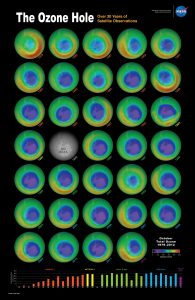The ozone layer is an invisible layer of protection around the planet that protects us from the sun’s harmful rays. This crucial layer is depleting because of pollution, mainly Chlorine and Bromide found in Chloro-floro carbons (CFCs). When these toxic gases reach the upper atmosphere, they make holes in the ozone layer. The biggest hole is above Antarctica.

Layers of the atmosphere
In the 1970s, ozone depletion was a huge concern. Several countries, including the United States, banned the use of CFCs as aerosol propellants. However, global production of CFCs has grown rapidly as new uses were found for these chemicals. Refrigeration, fire suppression, and foam insulation are the major uses for these chemicals today. When these items are thrown away and/or broken, the CFCs get released into the atmosphere.
One atom of chlorine can destroy more than 100,000 ozone molecules. This is a major issue because the ozone cannot be replaced fast enough. The hole over Antarctica reoccurs every year from August to October. Recently NASA scientists have documented proof that the hole is actually recovering because of the CFC phase-down. If efforts keep pushing to use fewer CFCs, the ozone layer is projected to heal in the (non-polar) Northern Hemisphere by the 2030s. The Southern Hemisphere will heal by the 2050s and the polar regions by 2060.
Sources:
https://www.epa.gov/ozone-layer-protection/basic-ozone-layer-science
https://www.nationalgeographic.com/environment/global-warming/ozone-depletion/
Photos:
https://aura.gsfc.nasa.gov/ozoneholeposter/
https://commons.wikimedia.org/wiki/File:Atmosphere_layers.jpg